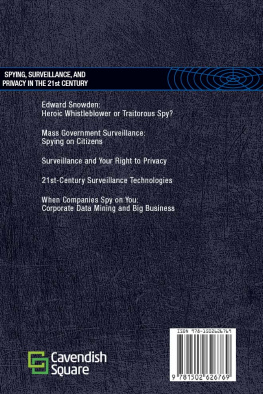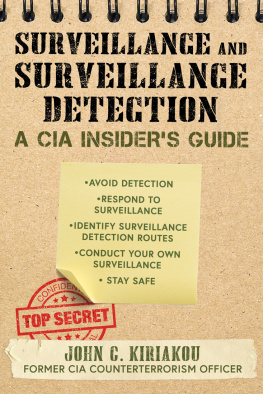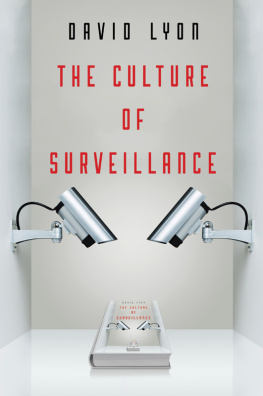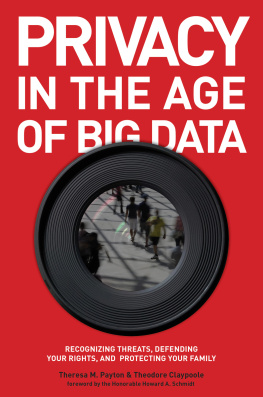
Also by ACM IV Security Services:
Secrets of Surveillance: A Professionals Guide to Tailing Subjects by
Vehicle, Foot, Airplane, and Public Transportation
Surveillance Countermeasures:
A Serious Guide to Detecting, Evading,
and Eluding Threats to Personal Privacy
by ACM IV Security Services
Copyright 1994, 2005 by ACM IV Security Services
ISBN 13: 978-1-61004-021-1
Print ISBN: 978-0-87364-763-2
ePub ISBN: 9781610047241
PDF ISBN: 9781610047234
Printed in the United States of America
Published by Paladin Press, a division of
Paladin Enterprises, Inc.,
Gunbarrel Tech Center
7077 Winchester Circle
Boulder, Colorado 80301 USA
+1.303.443.7250
Direct inquiries and/or orders to the above address.
PALADIN, PALADIN PRESS, and the horse head design
are trademarks belonging to Paladin Enterprises and
registered in United States Patent and Trademark Office.
All rights reserved. Except for use in a review, no
portion of this book may be reproduced in any form
without the express written permission of the publisher.
Neither the author nor the publisher assumes
any responsibility for the use or misuse of
information contained in this book.
Visit our Web site at www.paladin-press.com
Introduction to Surveillance Countermeasures
Surveillance Countermeasures Overview
Surveillance Principles and Tactics
Observation
Passive Physical Surveillance Detection
Active Physical Surveillance Detection Overview
Active Stakeout and Observation Post Detection Measures
Active Vehicular Surveillance Detection
Active Foot Surveillance Detection
Countersurveillance
Technical Surveillance Detection
Physical Antisurveillance
Antitechnical Surveillance
INTRODUCTION TO SURVEILLANCE COUNTERMEASURES
T his book was originally published during the last decade of the 20th century. Since that time, there has been an unanticipated proliferation of hostile covert elements that has significantly increased the threat to citizens, businesses, and national security interests of the United States and other democratic nations, both at home and abroad. For this reason, this books applicability has broadened significantly from the original target audience of a small core of security professionals to virtually everyone.
The techniques in this work were documented shortly after the conclusion of the Cold War and were in large part intended as a tribute to the legacy of the cloak-and-dagger intrigue that characterized that era. In those bipolar days, adversaries generally exercised mutual protocols in a high-stakes gentlemens game of spy versus spy. Even in the world of international terrorism during the previous era, there was a relatively rigid distinction between what were considered legitimate targets and off-limit targets (such as innocent civilians) that would result in negative sentiments toward the terrorist cause.
Today, terrorist and espionage operatives are less discriminate about the individuals they target, and criminal organizations have become less restrained in order to compete in the increasingly unscrupulous global crime market. These factors, coupled with the dynamics of globalization, are responsible for a much more dangerous world for many more people. As a general rule, there are no rules, and no one is exempt.
The new reality of the contemporary environment is characterized by a wide range of unconstrained and asymmetric threats that act with relatively less regard to consequence. In the past 15 years, we have experienced the development of a much more pervasive and dangerous underworldone that threatens a much broader stratum of society. Now there is a plethora of acute threats to the personal privacy and security of average citizens, including common criminals and stalkers, private and corporate investigative elements, international crime and terrorist organizations, government-sponsored espionage agencies, and, of course, radical Islamic terrorists who view all nonbelievers of Islam as infidels and enemies and therefore legitimate targets.
In virtually all cases, the elements that threaten individual, corporate, or national security conduct surveillance operations to further their objectives or as the primary means to an end. In todays hazardous environment, security professionals must understand the threat and be able to advise clients regarding the appropriate countermeasures to protect against a hostile surveillance effort. The average citizen, too, has a vested interest in understanding the concepts of surveillance countermeasures that can enhance personal security.
At the most basic level, criminals will case potential targets to develop information to maximize their probability of success in committing a crime. Sophisticated criminal organizations will conduct more extensive surveillance efforts to develop information on individuals they intend to intimidate, exploit, or terminate. Terrorist organizations conduct comprehensive preoperational surveillance to maximize the probability of successful attacks. In preparation for criminal or terrorist acts, surveillance is employed to determine when and where the target is most vulnerable.
Methods of international espionage have become much more aggressive toward nonmilitary and nongovernment targets. To a large degree, the intelligence services of foreign countries, both friend and foe, are competing in a global war based on economics. With less emphasis on military advantage and more on economic strength, the number of individuals who are vulnerable to espionage because of business affiliations is vastly increased. This expanding threat is further compounded by the ever-increasing practice of industrial espionage conducted between competing businesses.
Criminal, terrorist, and espionage organizations also employ surveillance in support of efforts to recruit or coerce individuals to provide information or other types of support. To this end, surveillance is employed to develop exploitable information on unwitting individuals. Those confronted with exploitable evidence developed through surveillance may be forced to cooperate rather than risk having the information disclosed to their families, employers, or the public. Attributes and vices such as infidelity, homosexuality, alcoholism, and drug abuse are some common examples of the limitless options possible for such blackmail operations. As a corollary, the majority of surveillance activities conducted by private investigative agencies are undertaken to confirm or deny whether an individual is conducting similar types of activities. Even individuals with no readily exploitable attributes can be manipulated into compromising situations to develop the leverage necessary for coercion.
Regardless of the nature of the threat, surveillance can be detected and defeated through the effective use of surveillance countermeasures. This book addresses the principles that have developed into time-proven methods of countering the most sophisticated surveillance techniques. Importantly in this age of terrorism, the very same surveillance countermeasures that are applicable to the detection of preoperational surveillance can prove critical when hostile elements are actually in the act of a crime or attack. This is the point when operators must expose themselves and are consequently most vulnerable to detection. Proficiency in the techniques of observation and surveillance countermeasures is an effective means to prevent the act or enable individuals to avoid the threat when in harms way.
Next page











